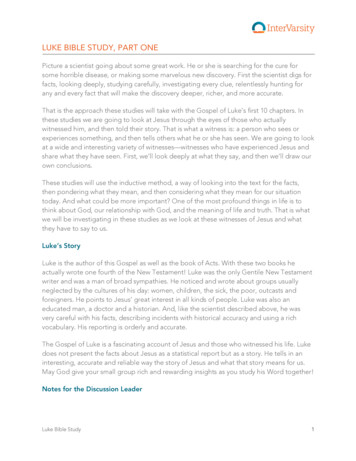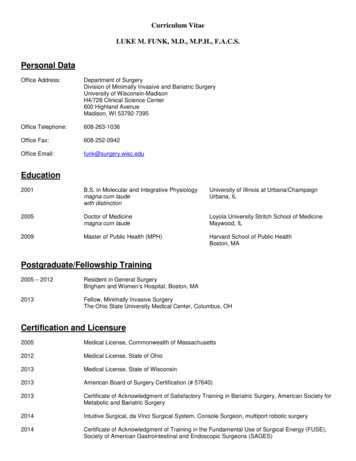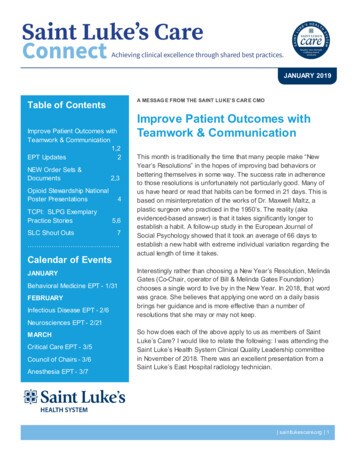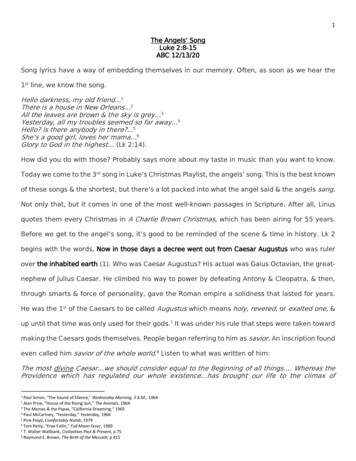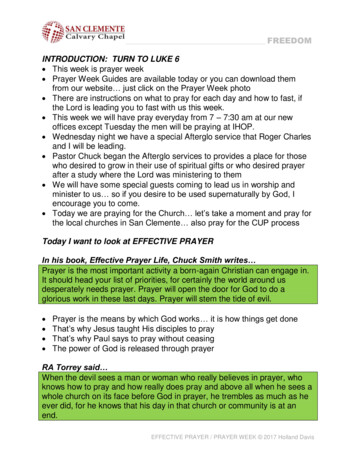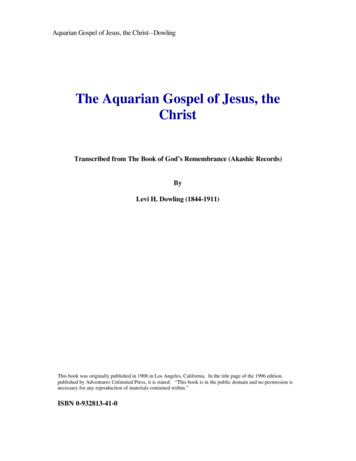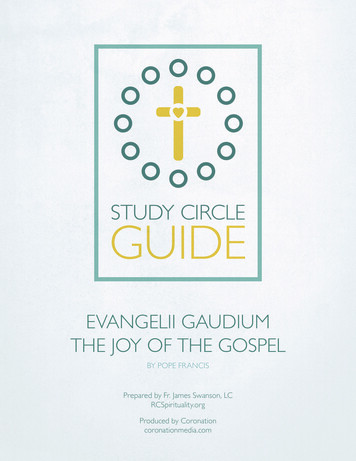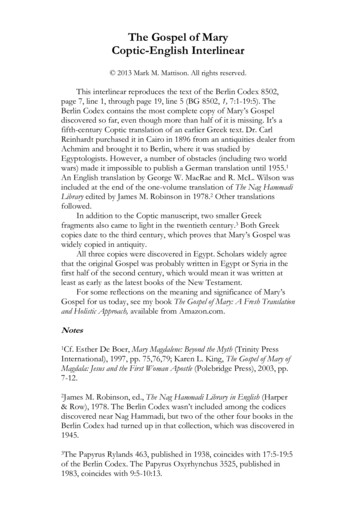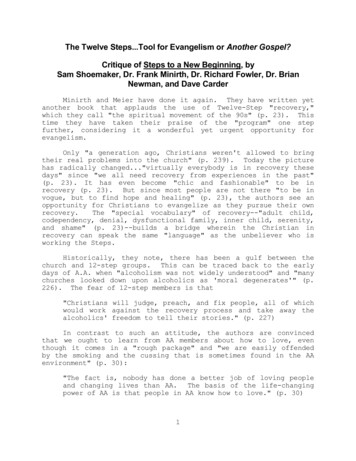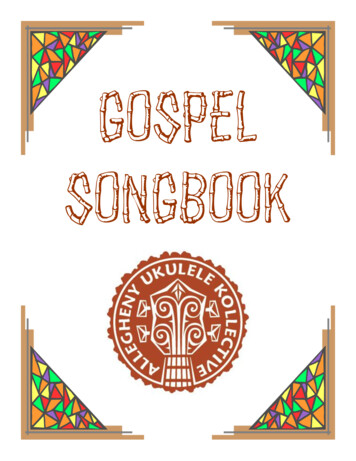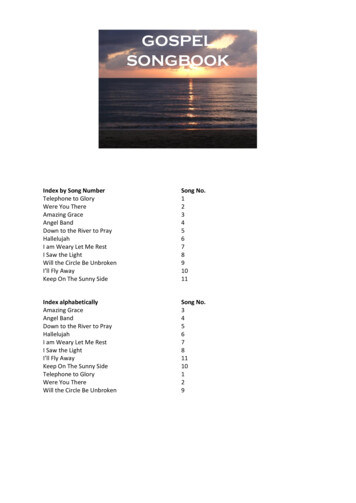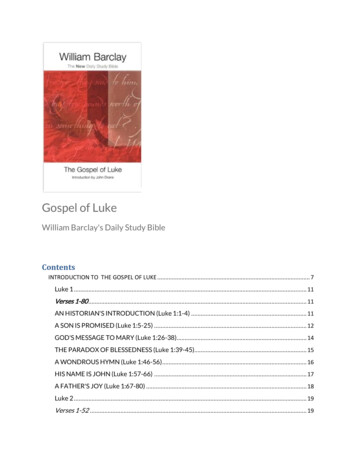
Transcription
Gospel of LukeWilliam Barclay's Daily Study BibleContentsINTRODUCTION TO THE GOSPEL OF LUKE . 7Luke 1 . 11Verses 1-80 . 11AN HISTORIAN'S INTRODUCTION (Luke 1:1-4) . 11A SON IS PROMISED (Luke 1:5-25) . 12GOD'S MESSAGE TO MARY (Luke 1:26-38). 14THE PARADOX OF BLESSEDNESS (Luke 1:39-45). 15A WONDROUS HYMN (Luke 1:46-56) . 16HIS NAME IS JOHN (Luke 1:57-66) . 17A FATHER'S JOY (Luke 1:67-80) . 18Luke 2 . 19Verses 1-52 . 19
JOURNEY TO BETHLEHEM (Luke 2:1-7) . 19SHEPHERDS AND ANGELS (Luke 2:8-20) . 21THE ANCIENT CEREMONIES ARE OBSERVED (Luke 2:21-24) . 22A DREAM REALIZED (Luke 2:25-35) . 23A LOVELY OLD AGE (Luke 2:36-40) . 24THE DAWNING REALIZATION (Luke 2:41-52 Continued) . 25Luke 3 . 26Verses 1-38 . 26THE COURIER OF THE KING (Luke 3:1-6). 26JOHN'S SUMMONS TO REPENTANCE (Luke 3:7-18) . 28THE ARREST OF JOHN (Luke 3:19-20) . 30THE HOUR STRIKES FOR JESUS (Luke 3:21-22) . 30THE LINEAGE OF JESUS (Luke 3:23-38) . 31Luke 4 . 33Verses 1-44 . 33THE BATTLE WITH TEMPTATION (Luke 4:1-13) . 34THE GALILAEAN SPRINGTIME (Luke 4:14-15) . 35WITHOUT HONOUR IN HIS OWN COUNTRY (Luke 4:16-30) . 37THE SPIRIT OF AN UNCLEAN DEVIL (Luke 4:31-37). 38A MIRACLE IN A COTTAGE (Luke 4:38-39). 40THE INSISTENT CROWDS (Luke 4:40-44). 40Luke 5 . 42Verses 1-39 . 42THE CONDITIONS OF A MIRACLE (Luke 5:1-11) . 42TOUCHING THE UNTOUCHABLE (Luke 5:12-15) . 43THE OPPOSITION INTENSIFIES (Luke 5:16-17) . 44FORGIVEN AND HEALED (Luke 5:18-26) . 46THE GUEST OF AN OUTCAST (Luke 5:27-32) . 47THE HAPPY COMPANY (Luke 5:33-35). 48THE NEW IDEA (Luke 5:36-39) . 50Luke 6 . 51
Verses 1-49 . 51THE INCREASING OPPOSITION (Luke 6:1-5) . 51THE DEFIANCE OF JESUS (Luke 6:6-11) . 52JESUS CHOOSES HIS MEN (Luke 6:12-19). 54THE END OF THE WORLD'S VALUES (Luke 6:20-26) . 55THE GOLDEN RULE (Luke 6:27-38). 56RULES FOR LIFE AND LIVING (Luke 6:39-46) . 58THE ONLY SURE FOUNDATION (Luke 6:47-49) . 59Luke 7 . 60Verses 1-50 . 60A SOLDIER'S FAITH (Luke 7:1-10) . 60THE COMPASSION OF CHRIST (Luke 7:11-17) . 61THE FINAL PROOF (Luke 7:18-29) . 63THE PERVERSITY OF MEN (Luke 7:30-35). 65A SINNER'S LOVE (Luke 7:36-50) . 66Luke 8 . 68Verses 1-56 . 68ON THE ROAD (Luke 8:1-3) . 68THE SOWER AND THE SEED (Luke 8:4-15) . 70LAWS FOR LIFE (Luke 8:16-18) . 72TRUE KINSHIP (Luke 8:19-21). 73CALM AMIDST THE STORM (Luke 8:22-25) . 74THE DEFEAT OF THE DEMONS (Luke 8:26-39) . 76AN ONLY CHILD IS HEALED (Luke 8:40-42; Luke 8:49-56) . 78NOT LOST IN THE CROWD (Luke 8:43-48) . 79Luke 9 . 81Verses 1-62 . 81EMISSARIES OF THE KING (Luke 9:1-9) . 81FOOD FOR THE HUNGRY (Luke 9:10-17). 82THE GREAT DISCOVERY (Luke 9:18-22) . 84THE CONDITIONS OF SERVICE (Luke 9:23-27) . 85
THE MOUNTAIN TOP OF GLORY (Luke 9:28-36) . 87COMING DOWN FROM THE MOUNT (Luke 9:37-45). 88TRUE GREATNESS (Luke 9:46-48) . 89TWO LESSONS IN TOLERANCE (Luke 9:49-56) . 90THE HONESTY OF JESUS (Luke 9:57-62) . 92Luke 10. 93Verses 1-42 . 93LABOURERS FOR THE HARVEST (Luke 10:1-16) . 93A MAN'S TRUE GLORY (Luke 10:17-20) . 94THE UNSURPASSABLE CLAIM (Luke 10:21-24) . 95WHO IS MY NEIGHBOUR? (Luke 10:25-37) . 96THE CLASH OF TEMPERAMENTS (Luke 10:38-42) . 98Luke 11. 100Verses 1-54 . 100TEACH US TO PRAY (Luke 11:1-4) . 100ASK AND YOU WILL RECEIVE (Luke 11:5-13). 101A MALICIOUS SLANDER (Luke 11:14-23) . 102THE PERIL OF THE EMPTY SOUL (Luke 11:24-28) . 104THE RESPONSIBILITY OF PRIVILEGE (Luke 11:29-32) . 105THE DARKENED HEART (Luke 11:33-36) . 106WORSHIP OF DETAILS AND NEGLECT OF THINGS THAT MATTER (Luke 11:37-44) . 107THE SINS OF THE LEGALISTS (Luke 11:45-54) . 109Luke 12. 110Verses 1-54 . 110TEACH US TO PRAY (Luke 11:1-4) . 111ASK AND YOU WILL RECEIVE (Luke 11:5-13). 112A MALICIOUS SLANDER (Luke 11:14-23) . 113THE PERIL OF THE EMPTY SOUL (Luke 11:24-28) . 114THE RESPONSIBILITY OF PRIVILEGE (Luke 11:29-32) . 115THE DARKENED HEART (Luke 11:33-36) . 116WORSHIP OF DETAILS AND NEGLECT OF THINGS THAT MATTER (Luke 11:37-44) . 118
THE SINS OF THE LEGALISTS (Luke 11:45-54) . 119Luke 13. 121Verses 1-35 . 121SUFFERING AND SIN (Luke 13:1-5) . 121GOSPEL OF THE OTHER CHANCE AND THREAT OF THE LAST CHANCE (Luke 13:6-9) . 122MERCY MORE THAN LAW (Luke 13:10-17) . 123THE EMPIRE OF CHRIST (Luke 13:18-19) . 125THE LEAVEN OF THE KINGDOM (Luke 13:20-21) . 126THE RISK OF BEING SHUT OUT (Luke 13:22-30) . 127COURAGE AND TENDERNESS (Luke 13:31-35) . 129Luke 14. 130Verses 1-35 . 130UNDER THE SCRUTINY OF HOSTILE MEN (Luke 14:1-6) . 130THE NECESSITY OF HUMILITY (Luke 14:7-11) . 132DISINTERESTED CHARITY (Luke 14:12-14) . 133THE KING'S BANQUET AND THE KING'S GUESTS (Luke 14:15-24). 134ON COUNTING THE COST (Luke 14:25-33) . 136THE INSIPID SALT (Luke 14:34-35) . 137Luke 15. 138Verses 1-32 . 138THE SHEPHERD'S JOY (Luke 15:1-7) . 138THE COIN A WOMAN LOST AND FOUND (Luke 15:8-10). 140THE STORY OF THE LOVING FATHER (Luke 15:11-32) . 141THREE LOST THINGS . 143Luke 16. 143Verses 1-31 . 143A BAD MAN'S GOOD EXAMPLE (Luke 16:1-13) . 143THE LAW WHICH DOES NOT CHANGE (Luke 16:14-18). 146THE PUNISHMENT OF THE MAN WHO NEVER NOTICED (Luke 16:19-31) . 147Luke 17. 148Verses 1-37 . 149
LAWS OF THE CHRISTIAN LIFE (Luke 17:1-10) . 149THE RARITY OF GRATITUDE (Luke 17:11-19) . 150THE SIGNS OF HIS COMING (Luke 17:20-37) . 151Luke 18. 153Verses 1-43 . 153UNWEARIED IN PRAYER (Luke 18:1-8) . 153THE SIN OF PRIDE (Luke 18:9-14) . 154THE MASTER AND THE CHILDREN (Luke 18:15-17) . 156THE MAN WHO WOULD NOT PAY THE PRICE (Luke 18:18-30) . 157THE WAITING CROSS (Luke 18:31-34) . 159THE MAN WHO WOULD NOT BE SILENCED (Luke 18:35-43). 160Luke 19. 161Verses 1-48 . 161THE GUEST OF THE MAN WHOM ALL MEN DESPISED (Luke 19:1-10) . 161THE KING'S TRUST IN HIS SERVANTS (Luke 19:11-27). 162THE ENTRY OF THE KING (Luke 19:28-40) . 164THE PITY AND THE ANGER OF JESUS (Luke 19:41-48) . 165Luke 20. 167Verses 1-47 . 167BY WHAT AUTHORITY? (Luke 20:1-8) . 167A PARABLE WHICH WAS A CONDEMNATION (Luke 20:9-18) . 168CAESAR AND GOD (Luke 20:19-26) . 170THE SADDUCEES' QUESTION (Luke 20:27-40) . 171THE WARNINGS OF JESUS (Luke 20:41-44). 172THE LOVE OF HONOUR AMONG MEN (Luke 20:45-47) . 173Luke 21. 174Verses 1-38 . 174THE PRECIOUS GIFT (Luke 21:1-4) . 174TIDINGS OF TROUBLE (Luke 21:5-24) . 175WATCH! (Luke 21:25-37). 178Luke 22. 179
Verses 1-71 . 179AND SATAN ENTERED INTO JUDAS (Luke 22:1-6). 179THE LAST MEAL TOGETHER (Luke 22:7-23) . 181STRIFE AMONG THE DISCIPLES OF CHRIST (Luke 22:24-30) . 183PETER'S TRAGEDY (Luke 22:31-38; Luke 22:54-62) . 184THY WILL BE DONE (Luke 22:39-46) . 185THE TRAITOR'S KISS (Luke 22:47-53) . 187MOCKING AND SCOURGING AND TRIAL (Luke 22:63-71) . 188Luke 23. 189Verses 1-56 . 189TRIAL BEFORE PILATE AND SILENCE BEFORE HEROD (Luke 23:1-12). 190THE JEWS' BLACKMAIL OF PILATE (Luke 23:13-25) . 191THE ROAD TO CALVARY (Luke 23:26-31) . 192THERE THEY CRUCIFIED HIM (Luke 23:32-38) . 194THE PROMISE OF PARADISE (Luke 23:39-43) . 195THE LONG DAY CLOSES (Luke 23:44-49) . 196THE MAN WHO GAVE JESUS A TOMB (Luke 23:50-56). 197Luke 24. 198Verses 1-53 . 198THE WRONG PLACE TO LOOK (Luke 24:1-12) . 198THE SUNSET ROAD THAT TURNED TO DAWN (Luke 24:13-35) . 200IN THE UPPER ROOM (Luke 24:36-49) . 202THE HAPPY ENDING (Luke 24:50-53) . 204INTRODUCTION TO THE GOSPEL OF LUKEA Lovely Book and its AuthorThe Gospel according to St Luke has been called the loveliest book in the world. When once anAmerican asked him if he could recommend a good life of Christ, the theologian James Denney
answered, 'Have you tried the one that Luke wrote?' There is a legend that Luke was a skilledpainter; there is even a painting of Mary in a Spanish cathedral to this day which purports to be byhim. Certainly he had an eye for vivid things. It would not be far wrong to say that the third gospelis the best life of Christ ever written. Tradition has always believed that. Luke was the author andwe need have no qualms in accepting that tradition. In the ancient world it was the regular thing toattach books to famous names; no one thought it wrong. But Luke was never one of the famousfigures of the early Church. If he had not written the gospel no one would have attached it to hisname.Luke was a Gentile; and he has the unique distinction of being the only New Testament writer whowas not a Jew. He was a medical man, a doctor by profession (Colossians 4:14), and maybe thatvery fact gave him the wide sympathy he possessed. It has been said that a minister sees men andwomen at their best; a lawyer sees them at their worst; and a doctor sees them as they are. Lukesaw men and women and loved them all.The book was written to a man called Theophilus. He is called most excellent Theophilus and thetitle given him is the normal title for a high official in the Roman government. No doubt Luke wrote itto tell an earliest inquirer more about Jesus; and he succeeded in giving Theophilus a picture whichmust have bound his heart closer to the Jesus of whom he had heard.The Symbols of the GospelsEvery one of the four gospels was written from a certain point of view. Very often on stained-glasswindows the writers of the gospels are pictured; and usually to each there is attached a symbol.The symbols vary but one of the commonest allocations is this.The emblem of Mark is a man. Mark is the simplest and most straightforward of the gospels. Ithas been well said that its characteristic is realism. It is the nearest to being a report of Jesus' life.The emblem of Matthew is a lion. Matthew was a Jew writing for Jews and he saw in Jesus theMessiah, the lion of the tribe of Judah, the one whom all the prophets had predicted.The emblem of John is the eagle. The eagle can fly higher than any other bird. It is said that of allcreatures only the eagle can look straight into the sun. John is the theological gospel; its flights ofthought are higher than those of any of the others. It is the gospel where the philosopher can findthemes to think about for a lifetime and to solve only in eternity.The symbol of Luke is the calf The calf is the animal for sacrifice; and Luke saw in Jesus the sacrificefor all the world. In Luke above all, the barriers are broken down and Jesus is for Jew and Gentile,saint and sinner alike. He is the Saviour of the world. Keeping that in mind, let us now set down thecharacteristics of this gospel.A Historian's CareFirst and foremost, Luke's gospel is an exceedingly careful bit of work. His Greek is notably good.The first four verses are well-nigh the best. Greek in the New Testament. In them he claims that hiswork is the product of the most careful research. His opportunities were ample and his sources
must have been good. As the trusted companion of Paul he must have known all the great figures ofthe Church, and we may be sure that he had them tell their stories to him. For two years he wasPaul's companion in imprisonment in Caesarea. In those long days he had every opportunity forstudy and research and he must have used them well.An example of Luke's care is the way in which he dates the emergence of John the Baptist:. Hedoes so by no fewer than six contemporary datings. 'In the fifteenth year of the reign of TiberiusCaesar [1], Pontius Pilate being governor of Judaea [2], Herod being tetrarch. of Galilee [3], and hisbrother Philip being tetrarch of the region of I.turaea and Trachonitis [41, and Lysanias tetrarch ofAbilene [5] in the high priesthood of Annas and Caiaphas [61, the word of God came to John' (Luke3:1-2, Revised Standard Version). Here is a man who is writing with care and who will be as accurateas it is possible for him to be.The Gospel for the GentilesIt is clear that Luke wrote mainly for Gentiles. Theophilus was a Gentile, as was Luke himself, andthere is nothing in the gospel that a Gentile could not grasp and understand. (1) As we have seen,Luke begins his dating from the reigning Roman emperor and the current Roman governor. TheRoman date conies first. (2) Unlike Matthew, he is not greatly interested in the life of Jesusas the fulfilment of Jewishprophecy. (3) He very seldom quotes the Old Testament at all. (4) He has a habit of giving Hebrewwords in their Greek equivalent so that a Greek would understand. Simon the Cananaeanbecomes Simon the Zealot (cf. Luke 6:15; Matthew [0:4). Calvary is called not by its Hebrewname, Golgotha, but by its Greek name, Kranion. Both mean the place of a skull. He never uses theJewish term Rabbi of Jesus but always a Greek word meaning Master. When he is tracing the descentof Jesus, he traces it not to Abraham, the founder of the Jewish race, as Matthew does, but to Adam,the founder of the human race (cf. Matthew :2; Luke 3:38).Because of this Luke is the easiest of all the gospels to read. He was writing, not for Jews, but forpeople very like ourselves.The Gospel of PrayerLuke's gospel is specially the gospel of prayer. At all the great moments of his life, Luke shows usJesus at prayer. He prayed at his baptism (3:2 t); before his first collision with the Pharisees (5: t6); before he chose the Twelve (6: f2); before he questioned his disciples as to who they thought hewas; before his first prediction of his own death (9:18);
Gospel of Luke William Barclay's Daily Study Bible
